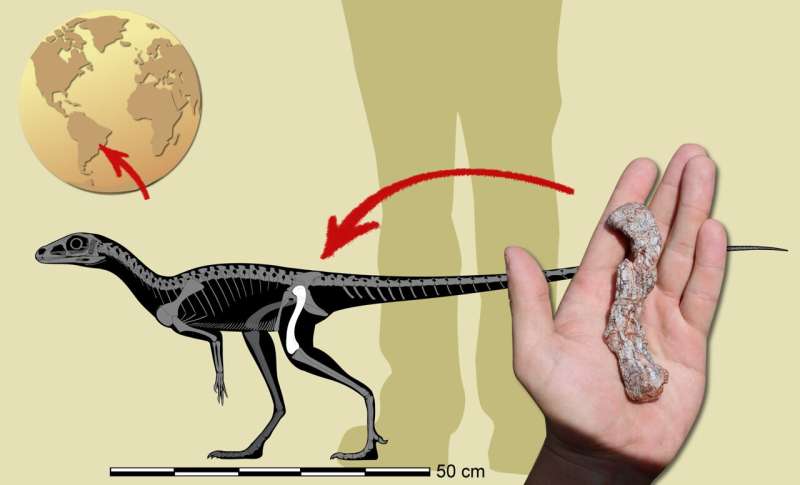Credit: skeleton by Maurício Silva Garcia; photo and composition by Rodrigo Temp Müller
Paleontologists from the Universidade Federal de Santa Maria (UFSM) published a study in the scientific periodic Gondwana Research describing the new fossilized specimen.
The oldest dinosaurs have been excavated from fossiliferous layers with approximately 233 million years from Brazil and Argentina. Furthermore, some older Argentinean deposits revealed remains of dinosaur precursors, which provide crucial data on the origin of "true" dinosaurs. These creatures lived approximately 236 million years ago and were small, with no more than 1 meter in length.
Whereas the fossil record of dinosaur precursors is relatively abundant in Argentina, there are no clear records of these animals from Brazil. Actually, no so far. A new specimen exhumed from the central region of the Rio Grande do Sul state revealed a set of traits unique from the group that encompasses the dinosaurs and their close relatives. The specimen was studied and published by the paleontologist from the Universidade Federal de Santa Maria Dr. Rodrigo Temp Müller and the Master's Degree student from the same institution Maurício Silva Garcia.
The fossil comprises a femur with 11 centimeters in length and bears diagnostic features that allows the assignation to the group named Dinosauromorpha. This group includes the dinosaurs and their close ancestors. Nevertheless, the most interesting fact is that the specimen was excavated from a fossiliferous site with approximately 237 million years. Therefore, it is the oldest record of a dinosaur precursor from South America. The fossil fills a gap in the Brazilian record and reveals that the dinosaur's ancestors lived in South America 1 million year before than previously expected.
Regarding the rest of the world, there are dinosaur precursors from Tanzania and Zambia that are possible older than the Brazilian record. However, some studies have questioned the age of these locations, indicating that these deposits are younger.
Another interesting fact relies on the fossilferous content from the site that yielded the new specimen. The fossiliferous site yielded numerous skeletons of large reptiles, such as the crocodile-relative Prestosuchus chiniquensis, a giant top tier predator with 7 meters in length. These creatures were far more abundant and larger than the dinosaur precursors, which were approximately 1 meter in length. Therefore, the dinosaur ancestors faced innumerous challenges before to evolve to large and dominant creatures in the next Periods of the Mesozoic Era.
More information: Rodrigo T. Müller et al, Oldest dinosauromorph from South America and the early radiation of dinosaur precursors in Gondwana, Gondwana Research (2022). DOI: 10.1016/j.gr.2022.02.010
Provided by Universidade Federal de Santa Maria
























